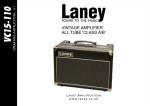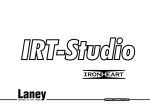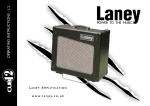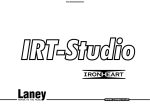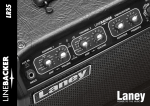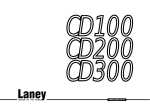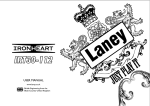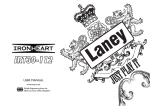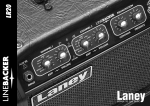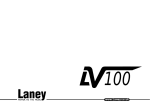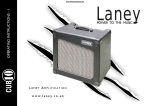Download Dynamix UM-A Plus/PL Specifications
Transcript
IRT60-212 WARNING: When using electrical products, basic cautions should always be followed, including the following: 1. Read these instructions. 2. Keep these instructions safe. 3. Heed all warnings. 4. Follow all instructions. 5. Do not use this apparatus near water. 6. Clean only with a dry cloth. 7. Do not block any of the ventilation openings. Install in accordance with manufacturer’s instructions. 8. Do not install near any heat sources such as radiators, heat registers, stoves or other apparatus (including amplifiers) that produce heat. 9. An apparatus with Class I construction shall be connected to a mains socket outlet with a protective connection. Do not defeat the safety purpose of the polarized or grounding-type plug. A polarized plug has two blades with one wider than the other. A grounding type plug has two blades and a third grounding prong. The wide blade or third prong is provided for your safety. If the provided plug does not fit into your outlet, consult an electrician for replacement of the obsolete outlet. 10. Protect the power cord from being walked on or pinched, particularly at plugs, convenience receptacles, and the point they exit from the apparatus. 11. Only use attachments/accessories provided by the manufacturer. 12. Use only with a cart, stand, tripod, bracket, or table specified by the manufacturer, or sold with the apparatus. When a cart is used, use caution when moving the cart/apparatus combination to avoid injury from tip-over. 13. The mains plug or appliance coupler is used as the disconnect device and shall remain readily operable. The user should allow easy access to any mains plug, mains coupler and mains switch used in conjunction with this unit thus making it readily operable. Unplug this apparatus during lightning storms or when unused for long periods of time. 14. Refer all servicing to qualified service personnel. Servicing is required when the apparatus has been damaged in any way, such as when power-supply cord or plug is damaged, liquid has been spilled or objects have fallen into the apparatus, the apparatus has been exposed to rain or moisture, does not operate normally, or has been dropped. 15. Never break off the ground pin. Connect only to a power supply of the type marked on the unit adjacent to the power supply cord. 16. If this product is to be mounted in an equipment rack, rear support should be provided. 17. Note for UK only: If the colours of the wires in the mains lead of this unit do not correspond with the terminals in your plug‚ proceed as follows: a) The wire that is coloured green and yellow must be connected to the terminal that is marked by the letter E‚ the earth symbol‚ coloured green or coloured green and yellow. b) The wire that is coloured blue must be connected to the terminal that is marked with the letter N or the colour black. c) The wire that is coloured brown must be connected to the terminal that is marked with the letter L or the colour red. 18.This electrical apparatus should not be exposed to dripping or splashing and care should be taken not to place objects containing liquids, such as vases, upon the apparatus. 19. Exposure to extremely high noise levels may cause a permanent hearing loss. Individuals vary considerably in susceptibility to noise-induced hearing loss, but nearly everyone will lose some hearing if exposed to sufficiently intense noise for a sufficient time. The U.S. Government’s Occupational Safety and Health Administration (OSHA) has specified the following permissible noise level exposures: According to OSHA, any exposure in excess of the above permissible limits could result in some hearing loss. Earplugs or protectors to the ear canals or over the ears must be worn when operating this amplification system in order to prevent a permanent hearing loss, if exposure is in excess of the limits as set forth above. To ensure against potentially dangerous exposure to high sound pressure levels, it is recommended that all persons exposed to equipment capable of producing high sound pressure levels such as this amplification system be protected by hearing protectors while this unit is in operation. ATTENTION: L’utilisation de tout appareil électrique doit être soumise aux precautions d’usage incluant: 1. Lire ces instructions 2. Gardez ce manuel pour de futures références. 3. Prétez attention aux messages de précautions de ce manuel. 4. Suivez ces instructions. 5. N’utilisez pas cette unité proche de plans d’eau. 6. N’utilisez qu’un tissu sec pour le nettoyage de votre unité. 7. N’obstruez pas les systèmes de refroidissement de votre unité et installez votre unité en fonction des instructionsde ce manuel. 8. Ne positionnez pas votre unité à proximité de toute source de chaleur. 9. Un appareil avec la construction de la classe I sera relié à une sortie de douille de forces à un raccordement protecteur. Connectez toujours votre unité sur une alimentation munie de prise de terre utilisant le cordon d’alimentation fourni. 10. Protégez les connecteurs de votre unité et positionnez les cablages pour éviter toutes déconnexions accidentelles. 11. N’utilisez que des fixations approuvées par le fabriquant. 12. Lors de l’utilsation sur pied ou pole de support, assurez dans le cas de déplacement de l’ensemble enceinte/support de prévenir tout basculement intempestif de celui-ci. 13. Les forces branchent ou le coupleur d'appareils est utilisé pendant que le dispositif de débranchement et restera aisément fonctionnel. L'utilisateur devrait permettre l'accès facile à toutes les forces prise, à forces coupleur et à commutateur de forces utilisé en même temps que cette unité le rendant de ce fait aisément fonctionnel. Débranchez cet appareil pendant la foudre donne l' assaut à ou si inutilisé pendant de longues périodes. 14. Seul un technicien agréé par le fabriquant est à même de réparer/contrôler votre unité. Celle-ci doit être contrôlée si elle a subit des dommages de manipulation, d’utilisation ou de stockage (humidité,…). 15. Ne déconnectez jamais la prise de terre de votre unité. 16. Si votre unité est destinée a etre montée en rack, des supports arriere doivent etre utilises. 17. Note pour les Royaumes-Unis: Si les couleurs de connecteurs du cable d’alimentation ne correspond pas au guide de la prise secteur, procédez comme suit: a) Le connecteur vert et jaune doit être connectrer au terminal noté E, indiquant la prise de terre ou correspondantaux couleurs verte ou verte et jaune du guide. b) Le connecteur bleu doit être connectrer au terminal noté N, correspondnat à la couleur noire du guide. c) Le connecteur marron doit être connectrer au terminal noté L, correspondant à la couleur rouge du guide. 18. Cet équipement électrique ne doit en aucun cas être en contact avec un quelconque liquide et aucun objet contenant un liquide, vase ou autre ne devrait être posé sur celui-ci. 19. Une exposition à de hauts niveaux sonores peut conduire à des dommages de l’écoute irréversibles. La susceptibilité au bruit varie considérablement d’un individu à l’autre, mais une large majorité de la population expériencera une perte de l’écoute après une exposition à une forte puissance sonore pour une durée prolongée. L’organisme de la santé américaine (OSHA) a produit le guide ci-dessous en rapport à la perte occasionnée: D’après les études menées par le OSHA, toute exposition au delà des limites décrites ce-dessus entrainera des pertes de l’écoute chez la plupart des sujets. Le port de système de protection (casque, oreilette de filtrage,…) doit être observé lors de l’opération cette unité ou des dommages irréversibles peuvent être occasionnés. Le port de ces systèmes doit être observé par toutes personnes susceptibles d’être exposées à des conditions au delà des limites décrites ci-dessus. ACHTUNG: Beim Einsatz von Elektrogeräten müssen u.a. grundlegende Vorsichtsmaßnahmen befolgt werden: 1. Lesen Sie sich diese Anweisungen durch. 2. Bewahren Sie diese Anweisungen auf. 3. Beachten Sie alle Warnungen. 4. Befolgen Sie alle Anweisungen. 5. Setzen Sie dieses Gerät nicht in der Nähe von Wasser ein. 6. Reinigen Sie es nur mit einem trockenen Tuch. 7. Blockieren Sie keine der Lüftungsöffnungen. Führen Sie die Installation gemäß den Anweisungen des Herstellers durch. 8. Installieren Sie das Gerät nicht neben Wärmequellen wie Heizungen, Heizgeräten, Öfen oder anderen Geräten (auch Verstärkern), die Wärme erzeugen. 9. Ein Apparat mit Aufbau der Kategorie I wird an einen Hauptleitungseinfaßungsanschluß mit einem schützenden Anschluss angeschlossen. Beeinträchtigen Sie nicht die Sicherheitswirkung des gepolten Steckers bzw. des Erdungssteckers. Ein gepolter Stecker weistzwei Stifte auf, von denen einer breiter ist als der andere. Ein Erdungsstecker weist zwei Stifte und einen dritten Erdungsstift auf.Der breite Stift bzw. der dritte Stift dient Ihrer Sicherheit. Sollte der beiliegende Stecker nicht in Ihre Steckdose passen, wenden Sie sich bitte an einen Elektriker, um die ungeeignete Steckdose austauschen zu lassen. 10. Schützen Sie das Netzkabel, sodass niemand darauf tritt oder es geknickt wird, insbesondere an Steckern oder Buchsen und ihren Austrittsstellen aus dem Gerät. 11. Verwenden Sie nur die vom Hersteller erhältlichen Zubehörgeräte oder Zubehörteile. 12. Verwenden Sie nur einen Wagen, Stativ, Dreifuß, Träger oder Tisch, der den Angaben des Herstellers entspricht oder zusammen mit dem Gerät verkauft wurde. Wird ein Wagen verwendet, bewegen Sie den Wagen mit dem darauf befindlichen Gerät besonders vorsichtig, damit er nicht umkippt und möglicherweise jemand verletzt wird. 13. Die Hauptleitungen verstopfen, oder Gerätekoppler wird während die Trennung Vorrichtung benutzt und wird bereitwillig funktionell bleiben. Der Benutzer sollte einfachen Zugang zu allen möglichen Hauptleitungen Stecker, zu den Hauptleitungen Koppler und zum Hauptleitungen Schalter erlauben, der in Verbindung mit dieser Maßeinheit benutzt wird, die folglich ihn bereitwillig funktionell bildet. Trennen Sie diesen Apparat während der Blitzstürme oder wenn unbenutzt, für lange Zeitabschnitte. 14. Lassen Sie sämtliche Wartungsarbeiten von qualifizierten Kundendiensttechnikern durchführen. Eine Wartung ist erforderlich, wenn das Gerät in irgendeiner Art beschädigt wurde, etwa wenn das Netzkabel oder der Netzstecker beschädigt wurden, Flüssigkeit oder Gegenstände in das Gerät gelangt sind, das Gerät Regen oder Feuchtigkeit ausgesetzt wurde, nicht normal rbeitet oder heruntergefallen ist. 15.Der Erdungsstift darf nie entfernt werden. Schließen Sie nur an die Stromversorgung der Art an, die am Gerät neben dem Netzkabel angegeben ist. 16. Wenn dieses Produkt in ein Geräte-Rack eingebaut werden soll, muss eine Versorgung über die Rückseite eingerichtet werden. 17. Hinweis – Nur für Großbritannien: Sollte die Farbe der Drähte in der Netzleitung dieses Geräts nicht mit den Klemmen in Ihrem Stecker übereinstimmen, gehen Sie folgendermaßen vor: a) Der grün-gelbe Draht muss an die mit E (Symbol für Erde) markierte bzw. grüne oder grün-gelbe Klemme angeschlossen werden. b) Der blaue Draht muss an die mit N markierte bzw. schwarze Klemme angeschlossen werden. c) Der braune Draht muss an die mit L markierte bzw. rote Klemme angeschlossen werden. 18. Dieses Gerät darf nicht ungeschützt Wassertropfen und Wasserspritzern ausgesetzt werden und es muss darauf geachtet werden, dass keine mit Flüssigkeiten gefüllte Gegenstände, wie z. B. Blumenvasen, auf dem Gerät abgestellt werden. 19. Belastung durch extrem hohe Lärmpegel kann zu dauerhaftem Gehörverlust führen. Die Anfälligkeit für durch Lärm bedingten Gehörverlust ist von Mensch zu Mensch verschieden, das Gehör wird jedoch bei jedem in gewissem Maße geschädigt, der über einen bestimmten Zeitraum ausreichend starkem Lärm ausgesetzt ist. Die US-Arbeitsschutzbehörde (Occupational and Health Administration, OSHA) hat die folgenden zulässigen Pegel für Lärmbelastung festgelegt: Laut OSHA kann jede Belastung über den obenstehenden zulässigen Grenzwerten zu einem gewissen Gehörverlust führen. Sollte die Belastung die obenstehenden Grenzwerte übersteigen, müssen beim Betrieb dieses Verstärkungssystems Ohrenstopfen oder Schutzvorrichtungen im Gehörgang oder über den Ohren getragen werden, um einen dauerhaften Gehörverlust zu verhindern. Um sich vor einer möglicherweise gefährlichen Belastung durch hohe Schalldruckpegel zu schützen, wird allen Personen empfohlen, die mit Geräten arbeiten, die wie dieses Verstärkungssystem hohe Schalldruckpegel erzeugen können, beim Betrieb dieses Geräts einen Gehörschutz zu tragen. CUIDADO: Cuando use productos electrónicos, debe tomar precauciones básicas, incluyendo las siguientes: 1. Lea estas instrucciones. 2. Guarde estas instrucciones. 3. Haga caso de todos los consejos. 4. Siga todas las instrucciones. 5. No usar este aparato cerca del agua. 6. Limpiar solamente con una tela ceca. 7. No blacker ninguna de las salida de ventilación. Instalar de acuerdo a las instrucciones del fabricante. 8. No instalar cerca de ninguna Fuentes de calor come radiators, estufas, hornos u otros aparatos (incluyendo amplificadores) que produzcan calor. 9. Un aparato con la construcción de la clase I será conectado con un enchufe de zócalo de las cañerías con una conexión protectora. No retire la patilla protectora del enchufe polarizado o de tipo “a Tierra”. Un enchufe polarizado tiene dos puntas, una de ellas más ancha que la otra. Un enchufe de tipo “a Tierra” tiene dos puntas y una tercera “a Tierra”. La punta ancha (la tercera ) se proporciona para su seguridad. Si el enchufe proporcionado no encaja en su enchufe de red, consulte a un electricista para que reemplaze su enchufe obsoleto. 10. Proteja el cable de alimentación para que no sea pisado o pinchado, particularmente en los enchufes, huecos, y los puntos que salen del aparato. 11. Usar solamente añadidos/accesorios proporcionados por el fabricante. 12. Usar solamente un carro, pie, trípode, o soporte especificado por el fabricante, o vendido junto al aparato. Cuando se use un carro, tenga cuidado al mover el conjunto carro/aparato para evitar que se dañe en un vuelco. No suspenda esta caja de ninguna manera 13. Las cañerías tapan o el acoplador de la aplicación se utiliza mientras que el dispositivo de la desconexión y seguirá siendo fácilmente operable. El usuario debe permitir el acceso fácil a cualquier cañería enchufe, a las cañerías acoplador y al interruptor de las cañerías usado conjuntamente con esta unidad así que lo hace fácilmente operable. Desenchufe este aparato durante tormentas del relámpago o cuando es inusitado por períodos del tiempo largos. 14. Para cualquier reparación, acuda a personal de servicio cualificado. Se requieren reparaciones cuando el aparato ha sido dañado de alguna manera, como cuando el cable de alimentación o el enchufe se han dañado, algún líquido ha sido derramado o algún objeto ha caído dentro del aparato, el aparato ha sido expuesto a la lluvia o la humedad, no funciona de manera normal, o ha sufrido una caída. 15. Nunca retire la patilla de Tierra. Conecte el aparato sólo a una fuente de alimentación del tipo marcado al lado del cable de alimentación. 16. Si este producto va a ser enracado con más equipo, use algún tipo de apoyo trasero. 17. Nota para el Reino Unido solamente: Si los colores de los cables en el enchufe principal de esta unidad no corresponden con los terminales en su enchufe‚ proceda de la siguiente manera: a) El cable de color verde y azul debe ser conectado al terminal que está marcado con la letra E‚ el símbolo de Tierra (earth)‚ coloreado en verde o en verde y amarillo. b) El cable coloreado en azul debe ser conectado al terminal que está marcado con la letra N o el color negro. c) El cable coloreado en marrón debe ser conectado al terminal que está marcado con la letra L o el color rojo. 18. Este aparato eléctrico no debe ser sometido a ningún tipo de goteo o salpicadura y se debe tener cuidado para no poner objetos que contengan líquidos, como vasos, sobre el aparato. 19. La exposición a altos niveles de ruido puede causar una pérdida permanente en la audición. La susceptibilidad a la pérdida de audición provocada por el ruido varía segúnla persona, pero casi todo el mundo perderá algo de audición si se expone a un nivel de ruido suficientemante intenso durante un tiempo determinado. El Departamento para la Salud y para la Seguridad del Gobierno de los Estados Unidos (OSHA) ha especificado las siguientes exposiciones al ruido permisibles: De acuerdo al OSHA, cualquier exposición que exceda los límites arriba indicados puede producir algún tipo de pérdida en la audición. Protectores para los canales auditivos o tapones para los oídos deben ser usados cuando se opere con este sistema de sonido para prevenir una pérdida permanente en la audición, si la exposición excede los límites indicados más arriba. Para protegerse de una exposición a altos niveles de sonido potencialmente peligrosa, se recomienda que todas las personas expuestas a equipamiento capaz de producir altos niveles de presión sonora, tales como este sistema de amplificación, se encuentren protegidas por protectores auditivos mientras esta unidad esté operando. SPECIFICATIONS IRT60H Supply Voltage (factory preset) ~100V, ~120V, ~220V,~230V, ~240V 50/60Hz Mains Fuse HT Fuse Power Consumption Output Power Rating ~100V/~120V: T5A L 250V ~220V/~230V/~240V: T2A L 250V T500mA L 200 Watts 60 Watts Input Impedance Loudspeaker 1MOhm 2 x Custom designed HH acoustics 12" drivers (16 Ohm) Loudspeaker Outputs 4, 8 or 16 Ohms EQ Per Channel: Passive Bass, Mid, Treble with switchable Deep, Mid Shift & Treble Shift Master Section: Dynamics & Tone Laney-designed digital reverb 4 x 12AX7/ECC83 preamp tubes 2 x 6L6 output tubes Pre-Boost Input Control “Watts” Output Level Control Switchable channels, with switchable Clean mode 1 x 5 pin DIN socket (FS4-IRT - included): Channel, Clean, Reverb, Boost 2 x 1/4" stereo jack (FS2): Channel + Clean, Reverb + Boost Reverb Features Footswitch options Unit Weight Dimensions (mm) 36.5Kg W 715 x H 526 x D 228 Forged deep within the Black Country - the metal beating industrial heartland of the UK - where the sound of metal guitar was born, comes the IRONHEART. With molten metal flowing through its circuits, IRONHEART continues the legacy passed on by previous Laney amps such as KLIPP and AOR, and hits you hard between the eyes like a power hammer from hell. When cranked, the IRONHEART possesses massive amounts of gain, but is equally at home providing smooth rock and clean tones. Like its 80's metal predecessor the AOR, each IRONHEART channel features 3-band EQ push/pull pots for extreme tone shaping and flexibility. Along with a Watts control, which allows the output of an IRONHEART to be screwed right down to less than 1 watt output power, the IRONHEART also features a foot switchable Pre-Boost function which works just like kicking in a gain pedal in front of your amp. The IRT60-212 combo features two independent channel controls, with a switchable clean mode, for extra versatility. It is loaded with 2 12" custom designed HH Acoustics speakers. Combine your IRONHEART head with an IRT412 or IRT212 speaker cabinet for the ultimate tonal experience. FRONT PANEL CONTROLS (Pull Shift) (Pull Shift) (Pull Deep) 1. INPUT 1/4" mono jack socket. Connect your guitar here. Use only a good quality instrument cable. 2. PRE-BOOST SWITCH Switches the input boost circuit on or off. The Pre-Boost circuit increases the input signal to the preamp tubes, just like placing a boost pedal in your signal path. This drives the preamp tubes harder, resulting in more distortion. This works on both channels. 3. PRE-BOOST CONTROL Controls the level of boost applied to the guitar signal. 4. PRE-BOOST LED This LED will illuminate when the Pre-Boost controls are activated. 5. LEAD GAIN Controls the level of preamp gain on the Lead channel. Turning this control clockwise will add more distortion to your guitar signal, ranging from light overdrive, to full on metal. Use this in conjunction with Lead Volume (8) to achieve the correct volume and distortion level you require. 6. LEAD EQ CONTROLS These are a traditional set of passive tone controls. Passive controls have the advantage of always sounding musical at any of their settings, due to their unique interactive nature. This gives the player a more natural set of tools to shape their ideal sound. Set these to midway (0) as a good starting point. 7. LEAD EQ PULL SWITCHES Pulling on each of the EQ control knobs will shift the response of each control as follows: !Bass: Deep - This extends the low-end frequency response, resulting in a fuller, heavier sound for lower notes. !Mid: Shift - This lowers the frequency range of the mid control to give a tighter sound. !Treble: Shift - This broadens the Treble control frequency response, to give a rounder sound to higher notes, especially when used with thin sounding pickups. 8. LEAD VOLUME Controls the Lead channel volume. Experiment with different combinations of the Gain and Volume controls to achieve different sounds. Reducing the Gain while increasing the Volume will result in a warm, open, overdriven sound as the power amp is driven harder, while reducing the Volume and increasing the Gain will give a tighter, more modern sound with more distortion. Once set, try using your guitar's volume controls to interactively adjust tone and distortion levels. FRONT PANEL CONTROLS 9. CHANNEL SWITCH Switches between the Lead and Clean/Rhythm channels. 10. CHANNEL LEDS Indicates which channel is currently selected by the Channel Switch (9). 11. CLEAN/RHYTHM SWITCH This switch activates the Clean mode on the Rhythm channel. When operated, the Clean Volume (12) control becomes active, while Rhythm Gain (14) and Rhythm Volume(17) are removed from the signal path. When using clean mode, the preamp gain is lowered, resulting in a cleaner tone. 12. CLEAN VOLUME Use this to control the volume of the amplifier when using clean mode. The amp can still be driven to overdrive with the control turned fully clockwise, and can be driven harder by using the Pre-Boost. 13. CLEAN LED This LED will illuminate when Clean mode is activated. 14. RHYTHM GAIN as Lead Gain (5) 15. CLEAN/RHYTHM EQ CONTROLS as Lead EQ Controls (6) 16. CLEAN/RHYTHM EQ PULL SWITCH as Lead EQ Pull Switch (7) 17. RHYTHM VOLUME as Lead Volume (8) 18. DYNAMICS This allows control over the response of the amplifier at lower frequencies. Turning this control clockwise gives a looser low end, while lower settings provide a tighter response. The optimum setting is dependant on the speaker cabinet used. 19.TONE This Tone control works in a similar fashion to the Tone control you probably have on your guitar except that it uniquely works at the other end of the amplification chain. This has the ability to not only control the overall top end response but also reduce upper harmonics on the output stage and preamplifier overdrive sounds. This will give you bright cutting sounds at high settings and smooth rounded sounds at lower settings. Midway (0) is a good starting point. Both the Tone and Dynamics controls depend greatly on the speaker cabinet connected to the amplifier. 20. REVERB Controls the level of the built in Laney-designed digital reverb. 21. WATTS The Watts control adjusts the signal level within the power amplifier, allowing it to be driven harder at lower volume levels. For full output power, running the power tubes at maximum levels, turn this control fully clockwise. To reduce output volume, turn this control to the left. This can be useful in practice environments, or when it is desirable to push the preamp hard but control the output level. 22. STANDBY SWITCH Disconnects the main HT voltage from the tubes but keeps the tubes warm so that they are ready to play instantly. Switch for short breaks when you don't want to wait for the tubes to warm up again. With the switch in the 1 (up) position, the amp is in play mode, while 0 (down) allows the amp to warm up. 23. STANDBY LAMP This will illuminate when the amplifier is in play mode. 24. POWER SWITCH Main power switch for the unit. Tube amplifiers take between 30 seconds to 2 minutes to warm up and be ready to play after switching on, this is normal. Use in conjunction with the standby switch to prolong tube life. To turn on, flip the switch to 1 (up). 25. POWER LAMP This will illuminate when the power switch is operated, indicating the presence of mains power within the amplifier. REAR PANEL CONTROLS IRT60-212 LZB1 2 3 4 N15039 1. MAINS INLET SOCKET Connect to your power source. Make sure the voltage indicated on the rear panel is correct for your country! 2. MAINS FUSE This drawer contains the main safety fuse for the unit. The fuse protects the amplifier from damage in the event of fault by disconnecting the mains power supply. USE ONLY THE CORRECT SIZE AND RATING SPECIFIED ON THE PANEL. If a fuse blows or fails and a replacement of the same size and rating is installed which in turn blows, the amplifier has suffered a malfunction and needs immediate service from a qualified technician. DO NOT TRY A FUSE OF HIGHER RATING - Using a fuse that is too large in current rating may cause serious, irreparable damage to the amplifier and presents a serious fire hazard. The mains fuse ratings are detailed in the Specifications section of this manual, as well as printed on the rear of the amplifier. There is a spare fuse located in the fuse drawer of the mains power inlet in the event of a failure. 3. HT FUSE This fuse disconnects the high voltage DC power to the tubes within the amplifier in the event of a fault. USE ONLY THE CORRECT SIZE AND RATING FUSE AS SPECIFIED ON THE PANEL. If a fuse blows or fails and a replacement of the same size and rating is installed which in turn blows, the amplifier has suffered a malfunction. At this point check the output tubes, and replace faulty ones if required. Should tubes not be the problem refer the amplifier to a qualified service technician. DO NOT TRY A FUSE OF HIGHER RATING - Using a fuse that is too large in current rating may cause serious, irreparable damage to the amplifier. Fuses are designed to protect, do not take chances. 4. BIAS SWITCH This allows the use of either 6L6 or EL34 output tubes in your amplifier. Ensure that the switch is in the correct position for your output tubes, otherwise you may risk damaging your amplifier. The IRT60-212 is factory fitted with 2x matched 6L6 tubes. We recommend the use of matched sets of output tubes for optimum performance. REAR PANEL CONTROLS 5. FX RETURN 1/4" mono jack socket for the connection of the output of an external FX unit. This can also be used as a slave in for the power amp. As the FX Loop is an insert type, this will mute the preamp signal. 6. FX LOOP SWITCH Selects the FX Loop mode of operation: ! Bypass - Removes the FX Loop from the signal path. ! 0 dBu - For connection of FX units with a 0dBu nominal output level. ! -10dBu - For connection of FX units with a -10dBu nominal output level. As this is intended for devices with a lower output level, this switch increases the gain of the FX Loop by 10dB. 7. FX SEND 1/4" mono jack socket for connection to the input of an external FX unit. This can also be used as a line out for connection to another power amp slave input or for recording. 8. FOOTSWITCH CONNECTIONS All Ironheart amps are equipped with a 5 pin DIN socket for the connection of the supplied FS4-IRT footswitch, allowing remote operation of the following functions: Channel, Clean, Reverb, and Boost. Two 1/4" stereo jack sockets are also provided for the connection of an FS2 or equivalent footswitch, with Channel & Clean on one socket, and Reverb & Boost on the other. In order to use any footswitches, set Pre-Boost and Clean switches to ON, and Channel to Lead. 9. LOUDSPEAKER CONNECTIONS Five 1/4" mono jack sockets are provided for the connection of a variety of speaker cabinets. The IRT60-212 is equipped with 2 x 12" custom HH Acoustics 16 ohm loudspeakers connected in parallel, and should always be connected to the 8 ohm socket when used without an extension cabinet. When using the IRT212, or any other 8 ohm cabinet in conjunction with the internal speakers, use the 4 ohm (2 x 8 ohm) sockets. Mismatching your speaker impedance will reduce the performance of your amplifier, and in extreme cases may damage the unit. Never operate any tube amplifier without a load connected: serious irreparable damage may occur. QUICK START SETTINGS Set to preference Clean (Pull Shift) (Pull Shift) (Pull Deep) (Pull Shift) (Pull Shift) (Pull Deep) Lead Rock Rhythm Lead Metal (Pull Shift) Rhythm Lead Detuned Metal Rhythm (Pull Shift) USER SETTINGS (Pull Shift) (Pull Shift) (Pull Deep) (Pull Shift) (Pull Shift) (Pull Deep) (Pull Shift) (Pull Shift) (Pull Deep) (Pull Shift) (Pull Shift) (Pull Deep) TUBE AMP TIPS Tube amplifiers generally sound much warmer/sweeter than solid state transistor amplifiers but they also need a little more respect due to the fragile glass tubes. The Ironheart combo uses four 12AX7 preamp tubes, and two 6L6 output tubes which should give you years of trouble free service, however like all tube amps; it is important to treat it with a certain amount of care. Use the following steps as a guide for how to take care of your amplifier: ! Take care when moving the amplifier. Tubes are fragile glass components, they can easily be damaged if thrown in and out of vans. ! Make sure the impedance of your cabinets matches the setting on your amplifier. Improper impedance matching will result in reduced output power and compromised sound at best, and amplifier failure/shortened tube life at worst. ! Allow the amplifier to warm up to room temperature before switching it on: the sudden thermal shock can crack a cold glass tube enclosure, plus any moisture is bad news around high voltage electronics. ! After playing, allow the amplifier to cool down before moving. Hot tubes are more fragile than cool ones. ! Always use good quality loudspeaker cables: instrument cables are not capable of handling the load requirements of the loudspeaker and can short out. Replacing Tubes A tubes life expectancy is based upon a number of factors which include operating temperature, how hard and how often it is played, vibration due to travel, etc. Tubes should be changed in your amplifier if you notice any deterioration in your amplifiers sound or performance. Otherwise, they need not be changed at any regular interval. Typical problems with preamp tubes can be crackly noise, hiss, hum, and microphony. If they fail or exhibit reduced performance, preamp tubes can simply be swapped out with no further action required. Typical output tube problems can include a blown HT fuse, sound lacking in punch, sound lacking extreme highs or low, and low level hum. The output tubes can be replaced singly if you replace them with the exact same type AND grade as factory fitted, otherwise they should be replaced as a matched dual set. To change a tube, firstly switch off and unplug the amplifier from the mains supply. Wait for the tubes to cool down. Remove the rear protective grille held in place with four screws. Preamp tubes are protected with a screen can; to remove, push down and twist the can anti clockwise and then pull up. The tube can now be gently pulled out. Output tubes have a spring retainer which grips the base of the tube; push down on this with one hand, whilst gently rocking the tube with the other to remove. Take care when inserting the new tube in to make sure all pins are correctly aligned. If you have swapped the type of output tube (from 6L6 to EL34 for example) make sure that the bias switch on the rear panel is correctly set before powering on. The user should not attempt to service this product. Please refer all servicing to qualified service personnel. V1 Tube Type ECC83/12AX7 Hi Grade V2-4 ECC83/12AX7 Selected V10-11 6L6 LINE OUT FX SEND BLOCK DIAGRAM FX RETURN TREBLE SHIFT BYPASS 0 dBu -10dBu REVERB REVERB LEVEL Footswitch TREBLE LEAD VOLUME TREBLE SHIFT RHYTHM GAIN MID SHIFT BASS DEEP LEAD GAIN MID LEAD EQ Pre-Boost TREBLE BASS MID CLEAN/RHYTHM EQ CLEAN VOLUME RHYTHM VOLUME CLEAN/RHYTHM 16Ohms 8Ohms/2x16Ohms Watts Dynamics Master section controls Tone INPUT MID SHIFT DEEP LEAD/RHYTHM 4Ohms/2x8Ohms EXTERNAL LOUDSPEAKER 4-16 OHMS INTERNAL LOUDSPEAKERS 2 x 16 OHMS SAMPLE SETUP FX UNIT GUITAR Internal Speakers IRT60-212 LZB1 2 3 4 N15039 FS4-IRT FX UNIT GUITAR Internal Speakers IRT60-212 LZB1 2 3 4 N15039 IRT212 FS4-IRT OPERATING INSTRUCTIONS - Issue 1.3




















